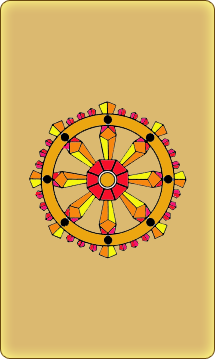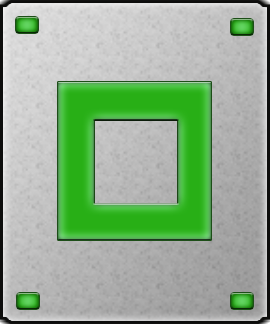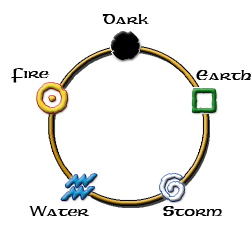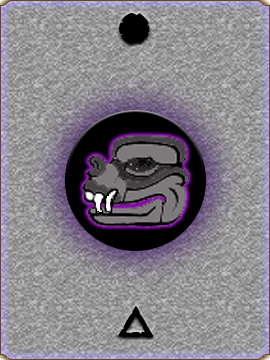
Roderick Robertson
Description

Decks of Godlearner tarot cards are made of paper, papyrus, parchment, or even thin sheets of silver, jade or granite. The size of the cards varies between “travel” decks measuring approximately 2x3 ˝ inches (50x88 mm) – the size of a modern business card – to luxurious decks measuring 5x8 inches (125x200). Decks are usually colored in some way relating to the runes on them. Some have elaborate pictures – such as pictures of the major Elemental Gods conquering their foes, etc.
Cults
Associated – Godlearners, some Godlearner remnant cults.Friendly – very few people have a clue to the origins of the cards.
Hostile – those few cults or people who do know where the cards came from
Knowledge
Automatic (Divination is a Cult Secret ), Common (decks from the time of the Godlearners are Extremely Rare)
History
Godlearner tarot were divination devices, training tools in the relationships of the runes, and used for various card games similar to Poker, Rummy, and Bridge.Entertainment was probably the greatest use of decks, with Rune training a strong second.
Using the decks for Divination (much like modern tarot) was always a Cult secret, with different schools of interpretation.
 Powers
Powers
A tarot deck has no powers in and of itself, unless it was enchanted in some way. Using the Tarot as a tool for divination helps the user focus their thoughts and discern the symbolic flow of power throughout the world.
Value
Decks vary tremendously in value, from torn, dirty parchment decks costing a few coppers, to inlaid and enameled silver-paper decks worth thousands of Silver just on their artistic merit.
The Tarot Deck
Developed after the Godlearners consolidated the runes into the system we know today, each deck consists of several “Courts” – the Elements, the Powers, the Forms, and the Conditions.
Elemental Court
 The Elemental Court consists of 50 cards. Each card has two elemental runes, based on the Elemental Progression (Masters of Luck and Death, pg 53). Each element is numbered 1-10, with the 1-5 paired with the 6-10 of the preceding (Superior) element, and the 6-10 paired with the following (Inferior) element. Cards are normally called by their Numbers and Rune, which can be be either rune: the “4-7 of Air” is the same as the “7-4 of Earth” (4 Air, 7 Earth). Naming the card depends on what game is being played, how the card is being played in the game, or which Rune is at the top of the card when it is dealt.
The Elemental Court consists of 50 cards. Each card has two elemental runes, based on the Elemental Progression (Masters of Luck and Death, pg 53). Each element is numbered 1-10, with the 1-5 paired with the 6-10 of the preceding (Superior) element, and the 6-10 paired with the following (Inferior) element. Cards are normally called by their Numbers and Rune, which can be be either rune: the “4-7 of Air” is the same as the “7-4 of Earth” (4 Air, 7 Earth). Naming the card depends on what game is being played, how the card is being played in the game, or which Rune is at the top of the card when it is dealt.There are cards for Dame Darkness, Sir Sea, Empress Earth, Lord Light and King Storm, sometimes counted as the “11-0” card for that element.
Power Court
The Power court consists of either four or five cards, depending on whether the creator of the deck recognized the Fate-Luck card. Each card consists of two opposed Powers: Harmony-Disorder, Fertility-Death, Stasis-Movement, Truth-Illusion and possibly Luck-Fate.
Form Court
The form court consists of cards marked with a particular Form rune. The usual forms included are Plant, Beast, Man, Dragonewt, Spirit, and sometime Chaos (Chaos is sometimes placed in the Condition Court, instead).
Condition Court
The Condition Court consists of four to six cards: Mastery, Magic, Infinity, Law and sometimes Balance. Chaos is sometimes placed in the Condition Court, rather than the Form Court.

Variant decks
Numerous variant decks can be found, from minor changes, such as the “Gods Deck” that names each card according to its Runic significance (the Fertility-Death card is either Kargan Tor or Uleria, depending on its orientation), to the “Mostal Deck” that classifies the Runes according to Gems and Minerals, and includes cards for the various races of Octagony, the Rock, Lead, Quicksilver, Copper, Tin, Brass, Silver and Gold (and Iron, Clay, and Diamond, in the so-called “heretical” decks).
Divination by Cartomancy
Cartomancy is a learnable skill, but it must be learned – no-one can use the cards as a divination tool until they have not only learned the cards, but also learned to interpret them and are able to “open” themselves to what the cards tell them.Inexperienced cartomancers are unable to use the cards on their own behalf – another person must pose a question, and the cartomancer interprets the cards in relation to that question. More skilled diviners can ask questions of the cards themselves, and interpret the answer.
Cartomancy can no more tell the future than any other form of Divination, though it can show the currents of the cosmic forces that are influencing the questioner.
Download your own deck!
Included in this issue is the "Simplified Peresk Deck", created sometime in the reign of Emperor Miglos by Sandalat of Peresk. It was intended as a "beginner's" deck, made of inexpensive papyrus or paper, with simple inked designs of the runes.Download the file, print out the cards, attach them to old playing cards, and make up your own games and "Divinatory Patterns". I have found that "Reading the tarot" can even help me plan scenarios and adventures! There are many ways to read the Tarot in the real world - experiment with them, or create spreads unique to Glorantha
(I'd be happy to publish articles on variant games or spreads for these tarot; or better-looking Tarot decks! - editor)





